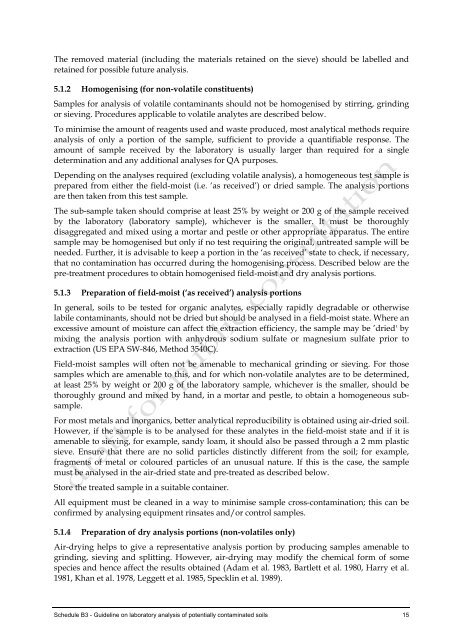Schedule B3 - COAG Standing Council on Environment and Water
Schedule B3 - COAG Standing Council on Environment and Water
Schedule B3 - COAG Standing Council on Environment and Water
- No tags were found...
Create successful ePaper yourself
Turn your PDF publications into a flip-book with our unique Google optimized e-Paper software.
The removed material (including the materials retained <strong>on</strong> the sieve) should be labelled <strong>and</strong><br />
retained for possible future analysis.<br />
5.1.2 Homogenising (for n<strong>on</strong>-volatile c<strong>on</strong>stituents)<br />
Samples for analysis of volatile c<strong>on</strong>taminants should not be homogenised by stirring, grinding<br />
or sieving. Procedures applicable to volatile analytes are described below.<br />
To minimise the amount of reagents used <strong>and</strong> waste produced, most analytical methods require<br />
analysis of <strong>on</strong>ly a porti<strong>on</strong> of the sample, sufficient to provide a quantifiable resp<strong>on</strong>se. The<br />
amount of sample received by the laboratory is usually larger than required for a single<br />
determinati<strong>on</strong> <strong>and</strong> any additi<strong>on</strong>al analyses for QA purposes.<br />
Depending <strong>on</strong> the analyses required (excluding volatile analysis), a homogeneous test sample is<br />
prepared from either the field-moist (i.e. ‘as received’) or dried sample. The analysis porti<strong>on</strong>s<br />
are then taken from this test sample.<br />
The sub-sample taken should comprise at least 25% by weight or 200 g of the sample received<br />
by the laboratory (laboratory sample), whichever is the smaller. It must be thoroughly<br />
disaggregated <strong>and</strong> mixed using a mortar <strong>and</strong> pestle or other appropriate apparatus. The entire<br />
sample may be homogenised but <strong>on</strong>ly if no test requiring the original, untreated sample will be<br />
needed. Further, it is advisable to keep a porti<strong>on</strong> in the ‘as received’ state to check, if necessary,<br />
that no c<strong>on</strong>taminati<strong>on</strong> has occurred during the homogenising process. Described below are the<br />
pre-treatment procedures to obtain homogenised field-moist <strong>and</strong> dry analysis porti<strong>on</strong>s.<br />
5.1.3 Preparati<strong>on</strong> of field-moist (‘as received’) analysis porti<strong>on</strong>s<br />
In general, soils to be tested for organic analytes, especially rapidly degradable or otherwise<br />
labile c<strong>on</strong>taminants, should not be dried but should be analysed in a field-moist state. Where an<br />
excessive amount of moisture can affect the extracti<strong>on</strong> efficiency, the sample may be ’dried' by<br />
mixing the analysis porti<strong>on</strong> with anhydrous sodium sulfate or magnesium sulfate prior to<br />
extracti<strong>on</strong> (US EPA SW-846, Method 3540C).<br />
Field-moist samples will often not be amenable to mechanical grinding or sieving. For those<br />
samples which are amenable to this, <strong>and</strong> for which n<strong>on</strong>-volatile analytes are to be determined,<br />
at least 25% by weight or 200 g of the laboratory sample, whichever is the smaller, should be<br />
thoroughly ground <strong>and</strong> mixed by h<strong>and</strong>, in a mortar <strong>and</strong> pestle, to obtain a homogeneous subsample.<br />
For most metals <strong>and</strong> inorganics, better analytical reproducibility is obtained using air-dried soil.<br />
However, if the sample is to be analysed for these analytes in the field-moist state <strong>and</strong> if it is<br />
amenable to sieving, for example, s<strong>and</strong>y loam, it should also be passed through a 2 mm plastic<br />
sieve. Ensure that there are no solid particles distinctly different from the soil; for example,<br />
fragments of metal or coloured particles of an unusual nature. If this is the case, the sample<br />
must be analysed in the air-dried state <strong>and</strong> pre-treated as described below.<br />
Store the treated sample in a suitable c<strong>on</strong>tainer.<br />
All equipment must be cleaned in a way to minimise sample cross-c<strong>on</strong>taminati<strong>on</strong>; this can be<br />
c<strong>on</strong>firmed by analysing equipment rinsates <strong>and</strong>/or c<strong>on</strong>trol samples.<br />
5.1.4 Preparati<strong>on</strong> of dry analysis porti<strong>on</strong>s (n<strong>on</strong>-volatiles <strong>on</strong>ly)<br />
Air-drying helps to give a representative analysis porti<strong>on</strong> by producing samples amenable to<br />
grinding, sieving <strong>and</strong> splitting. However, air-drying may modify the chemical form of some<br />
species <strong>and</strong> hence affect the results obtained (Adam et al. 1983, Bartlett et al. 1980, Harry et al.<br />
1981, Khan et al. 1978, Leggett et al. 1985, Specklin et al. 1989).<br />
<str<strong>on</strong>g>Schedule</str<strong>on</strong>g> <str<strong>on</strong>g>B3</str<strong>on</strong>g> - Guideline <strong>on</strong> laboratory analysis of potentially c<strong>on</strong>taminated soils 15
















